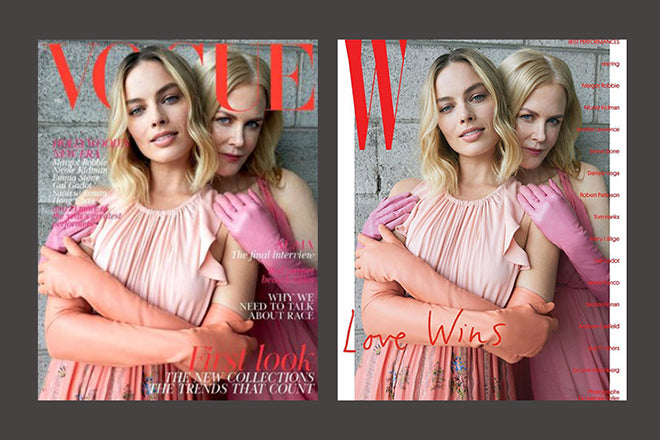
What’s happening at British Vogue?
Strange things are afoot at British Vogue. Despite its central role in British fashion – it has long been the sensible pole around which more radical fashion mags swing – the monthly has never offered much of interest to anyone beyond its core consituency. The only time I remember referencing it was in my 2001 book ‘Issues’; a redrawn Gill Sans headline face was a clever way to express its Englishness. Otherwise it’s some time since it led editorial design in any way (Terry Jones in the seventies?). But changes to its creative team last year hinted at an exciting 2018.
The replacement of long-time editor Alexandra Shulman, who’d been in the role for 25 years, by Edward Enninful promised a shift in emphasis. Shulman’s sensible, safe, journalistic approach to the magazine was to be replaced by a more high-octane celebrity focus. Celebrity subjects and celebrity photographers were the basics of Enninful’s previous work at US fashion title W, and his arrival naturally saw long-serving staffers leave.
His first issue of Vogue, the December 2017 issue, was packaged in a distinctive, if retro, cover shot of Adwoa Aboah by Steven Meisel (above). Both figures match the celebrity expectations invoked by Enninful’s appointment, while also supporting assumptions that he would improve the diversity of Vogue’s content (a minor fuss had occured as the editorial handover took place, with friends of Enninful highlighting the all-white editorial team he had inherited, and Shulman reacting over-defensively).
The long list of contributors and participants on the cover ticked all the right boxes, and I enjoyed the inclusion of long-time Vogue muse Kate Moss as the very last name on the list. So far, so good, if a little unspectacular.
The next issue featured a so-so moody Taylor Swift on the cover (above), and then this week the February cover was revealed. At this point things get super-weird.
The latest cover (above) pairs Margot Robbie and Nicole Kidman, a shot that is also one of six covers of the current issue of W magazine. Styled by Enninful and shot by Juergen Teller, the image is part of a portfolio of 29 movie stars featured in W. There is every possibility that the two magazines will sit side by side on international newsstands. It’s not unheard of for two magazines to use the same photo this way, but it would usually be regarded as an unfortunate coincidence.
More importantly, the collaboration seems balanced in favour of W at the expense of Vogue. Vogue’s previous editor and creative director had pride in their desire to be first to stories and understood the need for exclusivity – their exchanges on last year’s BBC documentary ‘Absolutely Fashion’ made that clear. Now we see the new editor of Vogue taking an edit from a longer story he’s created for W and using that as his cover story. What does that say about the position and role of Vogue?
The doubling up also offers a chance to compare the two design treatments, and the Vogue version fails since most of the coverlines are unreadable (one line that remains legible reads ‘Why we need to talk about race,’ which has already caused much comment as it appears next to two white actors. You can’t major on diversity without remaining alert to such own goals).
The shared cover shoot and poor editorial craft don’t promise great things for British Vogue. I’m not arguing against change, at the very least the magazine needs a a shot of adrenalin, but it does need to maintain basic editorial standards.
It remains unclear what the new Vogue wishes to be. This is emphasised by recents comments of Stefano Tonchi, editor-in-chief of W, about the future of his magazine: ‘From now on, each volume of W will be distinct and collectible, centered around a specific theme — in this case, film and fashion. We have upgraded our paper quality, improved the printing, and redesigned our layouts and typography; more significantly, we are focusing our attention on longer features and glorious visual portfolios.’
I’d love to read a similarly focused statement from British Vogue.
Editor: Edward Enninful
Creative director: Johan Svennson






